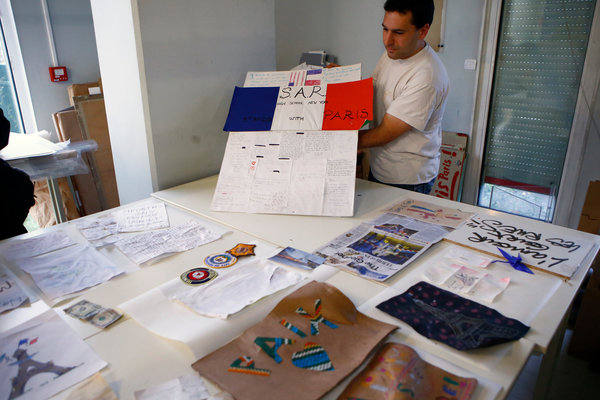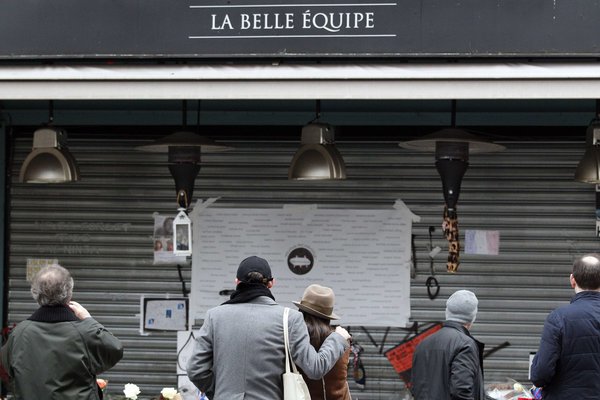For Ms. Pintault and Mr. Monpas, both archivists for the City of Paris, this was not the usual fare of musty public records and old administrative documents.
Instead, they were sifting through some of the tens of thousands of letters, drawings and other tokens of grief that have been left at makeshift memorials after the Nov. 13 attacks that killed 130 people. Assisted by the city’s cleaning services, and encouraged by groups of ordinary Parisians seeking to keep intact memories of the victims, the archivists have already collected thousands of documents.

Memorials have become a common sight after tragic events worldwide. But when the wave of grief slowly subsides and life returns to normal, deciding what to do with the piles of objects left behind can be tricky.
“We need to leave some of the objects, and at the same time, we need to make room for the sidewalk, sometimes even the road, so that life can go on,” said Guillaume Nahon, director of the Paris archives.
“It’s a day-to-day process, and a contradictory one too, because these memorials are supposed to be ephemeral, but people still need a place to mourn for now,” he said, standing near the Belle Équipe cafe, where 19 people where killed.
After the Sept. 11 attacks in New York, collectors there had to navigate the same difficult and ill-defined line between the moment that impromptu memorials were no longer growing organically and the moment that messages, flowers, origami cranes and other mementos had become refuse.
“You didn’t want to interrupt the life of a memorial while it was still in service,” said Mark Schaming, director of the New York State Museum in Albany. “On the other hand, you didn’t want to see it destroyed.”
In Paris, that difficulty is compounded by the freshness of the city’s wounds. The attacks came less than a year after three gunmen killed 17 people, including at the offices of the satirical newspaper Charlie Hebdo and at a kosher supermarket, in January. Those places became temporary sites of mourning, but none of the objects left there were archived, although the library at Harvard University recently began an initiative to collect such material.
Gérôme Truc, a sociologist who is publishing a book on reactions to some of the last decade’s deadliest terrorist attacks, said that the failure to archive could be attributed to the swift and unexpected nature of the January attacks.
This time, the City of Paris quickly mounted an effort to archive the material from Nov. 13, which will prove valuable to sociologists and historians.
Alice M. Greenwald, director of the National September 11 Memorial and Museum in New York, said sentiments at impromptu memorials after that attack ran the gamut. This is evident in the “Schuster scroll,” named for a student, Jordan Schuster, who taped down a piece of butcher paper at Union Square in Manhattan immediately after the attack on which people could write.
“Every possible emotion was reflected there,” Ms. Greenwald said. “Never forget. Immediate anger at politicians and whoever was responsible. Patriotic responses.”
Mr. Truc, who has studied Sept. 11 as well as the 2004 bombings in Madrid and the 2005 ones in London, said that the letters and notes at spontaneous memorials often countered prevailing media narratives or political discourse.
“What you always find, in all the attacks I’ve studied, is that people invoke love and peace,” Mr. Truc said, adding that President George W. Bush and President François Hollande of France had struck much more martial tones after attacks.
“If you don’t have these documents, you completely lose access to that dimension of things,” Mr. Truc said.

In front of La Belle Équipe, Marco Meurant, a city trash collector, sorted through objects left there. He carefully stepped around the carpet of letters, drawings and flowers, which were covered by a plastic sheet to protect against rain.
Like many of his colleagues, he volunteered to work on this assignment.
“It is the area where I work every day. I can’t feel unconcerned,” he said as he put an empty bottle and a decaying bouquet into a plastic bag.
It is those small connections that push people to spontaneously write notes, leave drawings and drop off flowers, Mr. Truc said. “These are rarely families of the victims, who are still traumatized.”
The messages are often very personal, sometimes painfully so. Emilie Legrand, who oversees restoration work at the Paris archives, has been collecting documents at the sites of the attacks — the restaurants and cafes, the Bataclan concert hall — and at Place de la République, where Parisians have gathered to mourn and celebrate for centuries.
“When we arrived on the first spot, at La Bonne Bière, I could not help myself and I read some of the messages,” Ms. Legrand said. “The one which struck me the most was the business card of a doctor, who wrote that he was sorry he was not able to save one of the men he tried to help after the shooting.”
The archivists are collecting some objects, like photographs or ticket stubs from the Bataclan, but their main focus is on letters and drawings.
In post-9/11 New York, the scope for archiving objects related to the attacks was somewhat wider. The ruins of the World Trade Center had not yet cooled before representatives of cultural institutions began collecting everything they could related to the attack.
The Port Authority of New York and New Jersey, the agency that built and owned the trade center, kept the largest artifacts, including train cars, in a hangar at Kennedy International Airport that is only now being emptied.
At the Paris archives, in the 19th Arrondissement, the documents will undergo a long and meticulous conservation process. In the storage room where Ms. Legrand and her team usually hunch over old city registers, dozens of boxes filled with material gathered after the attacks are organized in three categories: “dry, humid and soaked,” Ms. Legrand said.
Papers need to be dried to prevent mold, and some will require a special disinfection process. They will be inventoried, and some will be digitized.
Ordinary citizens are also involved through associations like 17 Plus Jamais, or 17 Never Again, a collective created after last January’s attacks that has maintained a makeshift memorial on Place de la République.
Some Parisians are also calling for a permanent memorial, or at the very least a website indexing some of the messages. Mr. Nahon, the archives director, said he was surprised by the interest in preserving the tributes.
“Even for me it is new, because as an archivist I usually complain about people’s indifference to the meaning of our work,” he said. “It is really the first time in my career that I am seeing such a need coming from ordinary people.”
















































